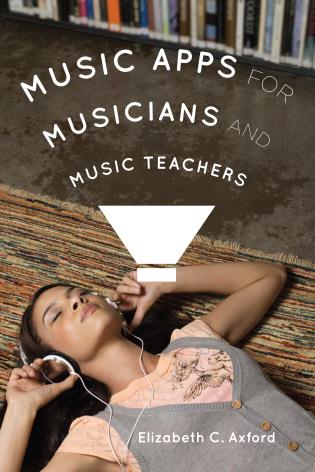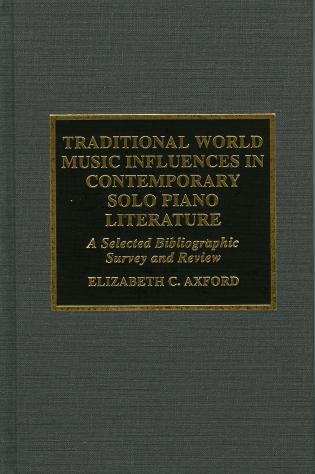Piano Press owner, Elizabeth C. Axford, M.A. has been contracted by Rowman & Littlefield Publishers as an author since 1996.
She has written five critically acclaimed music reference books found in libraries worldwide, including the following:
She has written five critically acclaimed music reference books found in libraries worldwide, including the following:

In today’s digital age, learning and creating music has never been so easy and affordable. Anyone can enhance their musical knowledge, skills, and creativity with the multitude of music apps available. However, sifting through thousands of music apps in the Apple App Store and Google Play can be a daunting task for any musician or music instructor. But not anymore! Having spent countless hours researching the most interesting useful, educational, fun, and easy-to-use music apps, Elizabeth C. Axford in Music Apps for Musicians and Music Teachers surveys the landscape of music-related apps for both iOS and Android mobile devices, including tablets and smartphones.
Music Apps for Musicians and Music Teachers lists hundreds of music-related apps organized by category, including singing, musical instruments, music theory and composition, songwriting, improvisation, recording, evaluating music performances, listening to music, music history and literature, music appreciation, and more. App developers are listed with each app, including links to their websites for updates and support. The book sections and chapters align with the newly revised National Standards for Music Education released in 2014 by the National Association for Music Education. Suggested activities for educators are provided, as well as key terms and a bibliography.
Music Apps for Musicians and Music Teachers is for anyone interested in music, whether hobbyist or professional. It enhances the ability to learn on the go by offering musicians, music students, and music instructors a list of the most useful music apps available.
"Music Apps for Musicians and Music Teachers offers a comprehensive and thorough survey of mobile device apps available for those who create, teach and perform music. Author Elizabeth Axford has an impressive and award-winning career as a musician, instructor, composer, and online-course facilitator. Her detailed research and resulting publication elevates the validity and the impact music-related apps carry in the world of music."
— American Music Teacher
Visit the Website and Blog for Music Apps for Musicians and Music Teachers!
Music Apps for Musicians and Music Teachers lists hundreds of music-related apps organized by category, including singing, musical instruments, music theory and composition, songwriting, improvisation, recording, evaluating music performances, listening to music, music history and literature, music appreciation, and more. App developers are listed with each app, including links to their websites for updates and support. The book sections and chapters align with the newly revised National Standards for Music Education released in 2014 by the National Association for Music Education. Suggested activities for educators are provided, as well as key terms and a bibliography.
Music Apps for Musicians and Music Teachers is for anyone interested in music, whether hobbyist or professional. It enhances the ability to learn on the go by offering musicians, music students, and music instructors a list of the most useful music apps available.
"Music Apps for Musicians and Music Teachers offers a comprehensive and thorough survey of mobile device apps available for those who create, teach and perform music. Author Elizabeth Axford has an impressive and award-winning career as a musician, instructor, composer, and online-course facilitator. Her detailed research and resulting publication elevates the validity and the impact music-related apps carry in the world of music."
— American Music Teacher
Visit the Website and Blog for Music Apps for Musicians and Music Teachers!

The third edition of Song Sheets to Software: A Guide to Print Music, Software, Instructional Media, and Web Sites for Musicians includes information on the history of printed music and publishing and copyright laws, as well as completely revised and updated listings of music software and other instructional media, web sites for musicians, and technical terms. In addition, Elizabeth C. Axford provides new information on instructional DVDs, book and audio CD sets, and music software programs for teaching everything from children's music to high-end professional recording.
The book is divided into 16 chapters by subject matter, such as Music Appreciation; Guitar and Bass; Country, Folk, and Traditional; and Vocal, Choral, Opera, and Musical Theater, offering both related software titles and web sites for each topic. New to the third edition is a CD-ROM supplying Live Links to the sites discussed, as well as an expanded and easily searchable Tech Talk and sample print music scores. The third edition also includes sections on digital sheet music, digital online collections of historical sheet music, video game music, and an updated bibliography. These updates and revisions make this the most complete resource of its kind available.
"This book is truly a grand resource for those in the music business."
— American Songwriter
"A unique work....This work continues to grow and get better with each new edition. Users will be able to tell that the author is both well informed in searching for music sites on the Internet as well as comfortable explaining to others how to research this topic....The book is recommended for a personal purchase for all music educators and applied teachers, and it is highly recommended for all academic and public library collections."
— American Reference Books Annual, May 2009
"The purpose of this book is to give help to those who may or may not read music, yet want and need to know more about music. It is about learning and teaching music through stimulating new ways involving computers and the internet...This highly organized publication is a very useful resource for those of us who teach and/or perform music."
— American Music Teacher
The third edition of Song Sheets to Software: A Guide to Print Music, Software, Instructional Media, and Web Sites for Musicians includes information on the history of printed music and publishing and copyright laws, as well as completely revised and updated listings of music software and other instructional media, web sites for musicians, and technical terms. In addition, Elizabeth C. Axford provides new information on instructional DVDs, book and audio CD sets, and music software programs for teaching everything from children's music to high-end professional recording.
The book is divided into 16 chapters by subject matter, such as Music Appreciation; Guitar and Bass; Country, Folk, and Traditional; and Vocal, Choral, Opera, and Musical Theater, offering both related software titles and web sites for each topic. New to the third edition is a CD-ROM supplying Live Links to the sites discussed, as well as an expanded and easily searchable Tech Talk and sample print music scores. The third edition also includes sections on digital sheet music, digital online collections of historical sheet music, video game music, and an updated bibliography. These updates and revisions make this the most complete resource of its kind available.
"This book is truly a grand resource for those in the music business."
— American Songwriter
"A unique work....This work continues to grow and get better with each new edition. Users will be able to tell that the author is both well informed in searching for music sites on the Internet as well as comfortable explaining to others how to research this topic....The book is recommended for a personal purchase for all music educators and applied teachers, and it is highly recommended for all academic and public library collections."
— American Reference Books Annual, May 2009
"The purpose of this book is to give help to those who may or may not read music, yet want and need to know more about music. It is about learning and teaching music through stimulating new ways involving computers and the internet...This highly organized publication is a very useful resource for those of us who teach and/or perform music."
— American Music Teacher

"Everything But Bach, Beethoven, and Brahms" comprises Traditional World Music Influences in Contemporary Solo Piano Literature, the multicultural repertoire guide for pianists, composers, music teachers and students, world music enthusiasts, and scholars. It identifies pieces in the contemporary solo piano literature which show world music influences not traditionally associated with the standard repertoire of Western European art music. The resulting annotated bibliography therefore includes pieces which use or attempt to emulate non-Western scales, modes, folk tunes, rhythmic, percussive or harmonic devices, and timbres.
Axford highlights the music cultures of the Middle East and North Africa, Sub-Saharan Africa, India, the Far East, Indonesia, Oceania, ethnic North America, Latin America and Spain, and Eastern Europe, Russia, and Scandinavia. Separate bibliographies for each world music region show examples of contemporary solo piano pieces that demonstrate some of the traditional musical influences associated with the region.
"The opening of each chapter describes the significant attributes of each ethnic style and cultural location in splendid detail. Academic music and large public libraries should consider purchasing."
— Choice Reviews
"The information gathered on these pages is tremendous and contemporary...a great source for building recital programs."
— Keyboard Teacher
"Axford has gone where few researchers have ventured by accepting the huge task of identifying and analyzing published solo piano music from around the world without duplicating the more standard work...each chapter begins with a fine scholarly overview...this ambitious reference work has no real parallel...this is the first time such information of international scope has been collected under the confines of one easy-to-use reference work...all libraries supporting general music programs or piano pedagogy should consider purchase of this valuable reference work."
— American Reference Books Annual
"The range is considerable..."
— Piano and Keyboard
"My husband, E. L. Lancaster, and I recently purchased Traditional World Music Influences in Contemporary Solo Piano Literature. It has been fun to browse through this book. It contains much useful information. Congratulations on a monumental publication."
— Gayle Kowalchyk, Alfred Publishing Co., Inc.
"A reference book for students, world music enthusiasts, and teachers...background materials offer helpful overviews of each culture's music..."
— Teaching Music